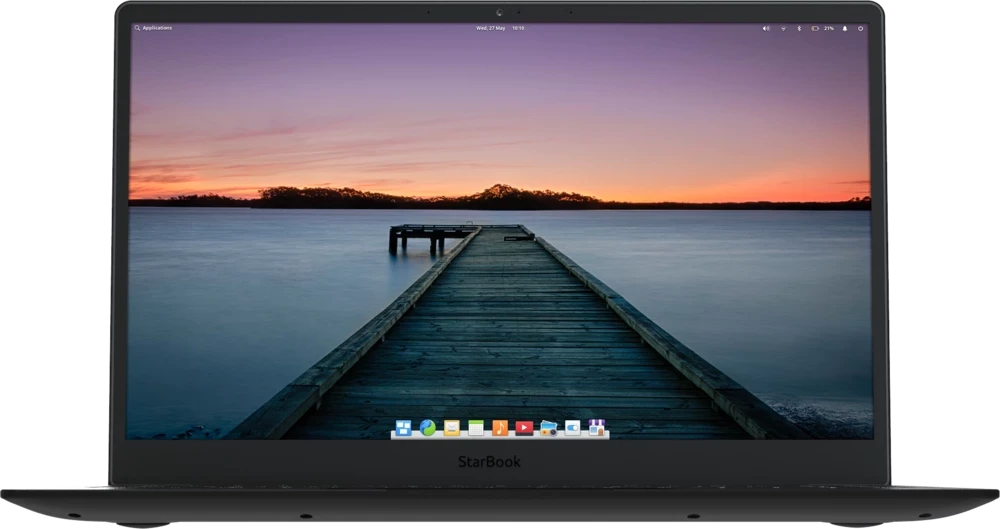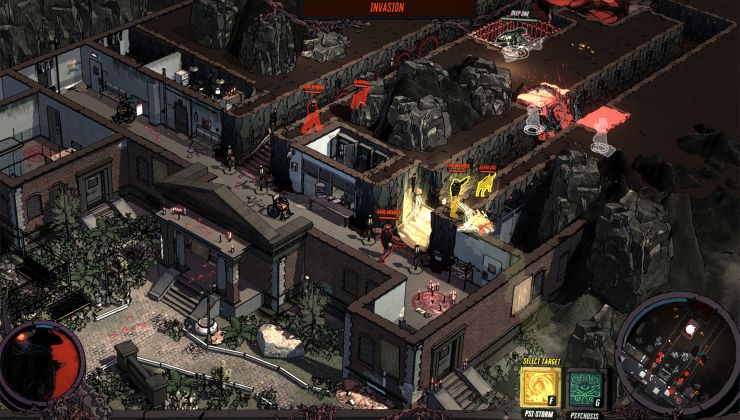Ready to drool over new Linux hardware? Star Labs are ready for you to open your wallets to the 14" StarBook Mk V. Now this is the type of laptop model I can get into. A screen that's not too big, a sleek chasis and a reasonable price backed up by some powerful internals along with it being designed for Linux.
With the new StarBook Mk V, you get quite a lot more choice too. When it comes to the BIOS, they're now letting you choose between AMI (American Megatrends Inc.) Aptio V and the open source Coreboot. Not only that, you can switch between them any time you want.
A nice matte screen as standard too with the 14-inch ARC display, with anti-reflective coating that should provide a good experience whever you are. Star Labs say it comes with a hard coating to prevent damage too.
Some of the specifications on offer:
| Chassis | Type II matte black anodised aluminium |
| Display | 14-inch (diagonal) LED-backlit matte display with IPS technology 1920x1080 resolution at 157 pixels per inch 16:9 aspect ratio |
| Processor |
2.4GHz dual-core Intel® Core® i3-1110G4 Configurable to: |
| Storage |
240GB Over-Provisioned SATA SSD Configurable to: Configurable to: Configurable to: Configurable to: Configurable to: |
| RAM |
8GB of 3200MHz DDR4 memory Configurable to: 64GB of 3200MHz DDR4 memory |
| Graphics |
Intel® UHD G4 Graphics Intel® Iris® Xe Graphics |
When it comes to operating systems you get a lot choice there too between: Ubuntu 20.04.2 LTS (64-bit) or later, elementary OS 5.1.7 (64-bit) or later, Linux Mint 20.1 (64-bit) or later, Manjaro 21.0 (64-bit) or later, MX Linux AHS 19.3 (64-bit) or later, Zorin OS 15.2 (64-bit) or later and even Windows.
Available from £777.00. Check out the official page to find out more and order.
While it has technically launched, it's currently in production, which may be delayed due to component shortages worldwide right now. They offer a 5% discount if you order a laptop that's in production and not yet ready.
I hadn't heard about ElementaryOS for a while. I go check them out and I discover they are behind a paywall now. So is not surprising that they disappeared from the news lately.
You can click Custom and enter zero: the Purchase button changes to Download...
What's the gaming like on the Xe graphics?It should be on par with currently competing Vega graphics. On AMD you get up to eight cores with a comparable power envelope though…
Bummer, 16:9 screen...Quite
16:9 has no place in smaller screens. 3:2 or 16:10 all the way.
Even in larger monitors 16:10 is much superior to 16:9.
Last edited by Dorrit on 5 May 2021 at 3:58 pm UTC
Bummer, 16:9 screen... I can't go back to it after having had many years of 3:2 laptop screens. I think the only vertically larger native option are the Lenovo Thinkpads and the Dells....That gives me a bizarro-world idea. So, for a lot of things you want to read/look at on a computer screen, you actually would want it to be taller than it is wide. Part of the reason they go with wider-than-tall is tradition dating back from TVs, and on laptops part is that they have to match the bottom half, with keyboard layouts having natural reasons to be wider than they are tall, at least if you're doing any fast touch-typing.
But how about a laptop design with a screen whose primary orientation was vertical? I can think of a few ways to manage it:
1. Strange keyboard layout. The screen simply hinges on a short side, and you have a keyboard that's laid out much more vertically. Not going to be winning any typing competitions, but if you're OK with that you've got this tall screen.
2. Screen opens on the short side, but has a narrow attachment to the base which you can slide around the edge to the middle of the long side, where it locks again and has contacts to power and so forth. You have a normally oriented keyboard with an odd looking vertical screen rising from it; to close it properly you slide it around again (because if you just folded it down from where it is the screen rectangle would be at right angles to the keyboard rectangle). Finicky, probably not durable.
3. Screen is detachable, basically a tablet, which you can have vertical or horizontal. But there's attachment points/clamps so that it will stand up, and be charged when attached to the keyboard.
4. Screen is attached on the long side, but it's actually attached to a hinged arm, not directly to the bottom half. So you open the laptop and it's a normal screen, but you can slide it up the arm and then pivot it vertical. The result is slightly "lumpy" when it's closed because you have this arm running down the back of the screen, but you could make the thing pretty flat.
Last edited by Purple Library Guy on 5 May 2021 at 5:04 pm UTC
I quite like my 32:10. Just wish more games supported it.Bummer, 16:9 screen...Quite
16:9 has no place in smaller screens. 3:2 or 16:10 all the way.
Even in larger monitors 16:10 is much superior to 16:9.
Here is the thing that bugs me...Bummer, 16:9 screen... I can't go back to it after having had many years of 3:2 laptop screens. I think the only vertically larger native option are the Lenovo Thinkpads and the Dells....That gives me a bizarro-world idea. So, for a lot of things you want to read/look at on a computer screen, you actually would want it to be taller than it is wide. Part of the reason they go with wider-than-tall is tradition dating back from TVs, and on laptops part is that they have to match the bottom half, with keyboard layouts having natural reasons to be wider than they are tall, at least if you're doing any fast touch-typing.
But how about a laptop design with a screen whose primary orientation was vertical? I can think of a few ways to manage it:
1. Strange keyboard layout. The screen simply hinges on a short side, and you have a keyboard that's laid out much more vertically. Not going to be winning any typing competitions, but if you're OK with that you've got this tall screen.
2. Screen opens on the short side, but has a narrow attachment to the base which you can slide around the edge to the middle of the long side, where it locks again and has contacts to power and so forth. You have a normally oriented keyboard with an odd looking vertical screen rising from it; to close it properly you slide it around again (because if you just folded it down from where it is the screen rectangle would be at right angles to the keyboard rectangle). Finicky, probably not durable.
3. Screen is detachable, basically a tablet, which you can have vertical or horizontal. But there's attachment points/clamps so that it will stand up, and be charged when attached to the keyboard.
4. Screen is attached on the long side, but it's actually attached to a hinged arm, not directly to the bottom half. So you open the laptop and it's a normal screen, but you can slide it up the arm and then pivot it vertical. The result is slightly "lumpy" when it's closed because you have this arm running down the back of the screen, but you could make the thing pretty flat.
So the movie industry and others all 'plot' to do away with 4:3 displays, or 5:4. Which we that are picky KNOW are better for actual work, as 16:9 is really only good for movie consumption. And even then, more and more movies do things like use 2.35:1, or you know Snyder doing 4:3 again... coders usually enjoy turning their monitors so they are 9:16.
Yet, someone, somewhere decided we should ditch optical drives on our computers, and forcing us to stream instead (via whatever methods, legal or not) so buying physical media is waning and they can get us on subscriptions... sorry, rambled a bit..
Anyhow, web sites, and documents in general usually have a specific margin and characters per line count which basically wastes space on wide screen displays. Basically, if you eliminate movie consumption (and video games in a sense, they also can be better with more horizontal space) then rea)y computer monitors should be taller, not wider.
Anyhkw, end of rant. These laptops look nice.
Intel = Meh, no thanks.
Seriously. Can we PLEASE stop with 16:9? It was bad in 2010, it was bad in 2015 and it's still bad in 2021. I get that they are cheaper than proper aspect panels, but come one.
16:9 is horrible on anything smaller than a 27". And even then it's not good. /rant >_<
16:9 = Big narp on that one. I'll keep my old 16:10 MacbookTux, tyvm.Yeah, I don't get it. I have a few 16:10 panels and my current set up is a 32:10. It is a much nicer ratio. The painful thing is so many games only support 16:9...
Intel = Meh, no thanks.
Seriously. Can we PLEASE stop with 16:9? It was bad in 2010, it was bad in 2015 and it's still bad in 2021. I get that they are cheaper than proper aspect panels, but come one.
16:9 is horrible on anything smaller than a 27". And even then it's not good. /rant >_<










 How to set, change and reset your SteamOS / Steam Deck desktop sudo password
How to set, change and reset your SteamOS / Steam Deck desktop sudo password How to set up Decky Loader on Steam Deck / SteamOS for easy plugins
How to set up Decky Loader on Steam Deck / SteamOS for easy plugins
See more from me